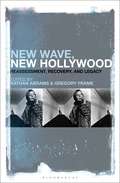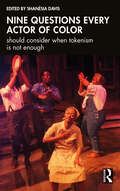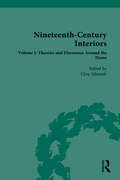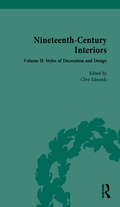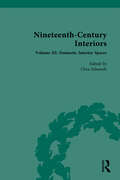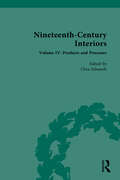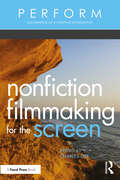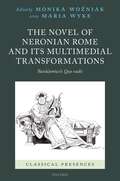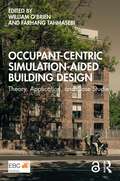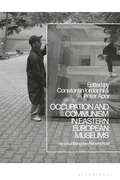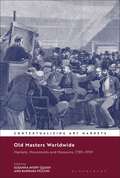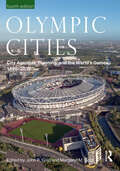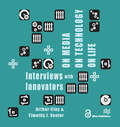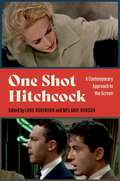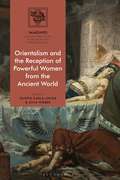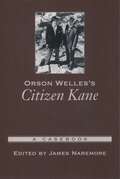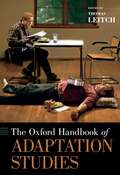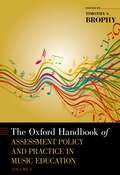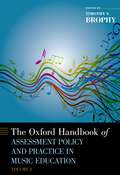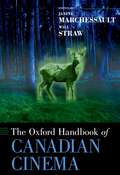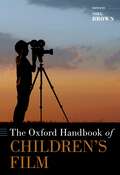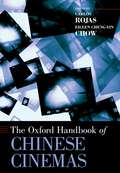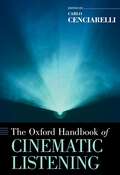- Table View
- List View
New Wave, New Hollywood: Reassessment, Recovery, and Legacy
As a period of film history, The American New Wave (ordinarily understood as beginning in 1967 and ending in 1980) remains a preoccupation for scholars and audiences alike. In traditional accounts, it is considered to be bookended by two periods of conservatism, and viewed as a (brief) period of explosive creativity within the Hollywood system. From Bonnie and Clyde to Heaven's Gate, it produced films that continue to be watched, discussed, analysed and poured over.It has, however, also become rigidly defined as a cinema of director-auteurs who made a number of aesthetically and politically significant films. This has led to marginalization and exclusion of many important artists and filmmakers, as well as a temporal rigidity about what and who is considered part of the 'New Wave proper'. This collection seeks to reinvigorate debate around this area of film history. It also looks in part to demonstrate the legacy of aesthetic experimentation and political radicalism after 1980 as part of the 'legacy' of the New Wave. Thanks to important new work that questions received scholarly wisdom, reveals previously marginalised filmmakers (and the films they made), considers new genres, personnel, and films under the banner of 'New Wave, New Hollywood', and reevaluates the traditional approaches and perspectives on the films that have enjoyed most critical attention, New Wave, New Hollywood: Reassessment, Recovery, Legacy looks to begin a new discussion about Hollywood cinema after 1967.
Nine questions every actor of color should consider when tokenism is not enough
This book confronts and analyzes the systemic racism that confronts actors of color in the USA through interviews with leading performers in the nation’s theatrical epicentre of Chicago.Each chapter deals with a different central question, from how these actors approach roles and the obstacles that they face, to the ways in which the industry can change to better enable actors of color. By bringing together these actors and sharing the ways in which they have functioned within the white theatre world, we can appreciate how theatre needs to embrace their identities so that all voices are heard, understood, and valued. The stories of these actors will reflect the systemic racism of the past and present with the hope of remaking the future.This is an important book for students, teachers, and professionals who engage in theatre work, helping them to understand the lived experiences of actors of color through those actors’ own words.
Nineteenth-Century Interiors: Volume I: Theories and Discourses Around the Home
This volume of primary source materials documents the nature of the home and the theories and discussions around the concept. It examines the class divisions that become evident with the ostentatious lifestyles of political and society hostesses at the peak, whilst middle-class housing often in suburbia, seemed to have created a separation of home and work, arguably suggesting men and women lived in separate spheres. Working-class interiors, often seen the eyes of middle-class observers, were at the bottom of the hierarchy and often reflected concerns of social inequality and misery. The documents also address the process of purchasing and decorating a home, advice on decoration and home management, the nature of taste and comfort, and the symbolic roles of the home as an anchor in society. Accompanied by extensive editorial commentary, this collection will be of great interest to students and scholars of art history.
Nineteenth-Century Interiors: Volume II: Styles of Decoration and Design
This volume of primary source materials documents the nineteenth-century search for a representative style, and the alternating fashions for interiors that demonstrated the consumerism of the period. Although in some senses every interior is unique so that a style canon may seem to be meaningless, there have been important historical trends or styles that have influenced individual interiors, and these have formed the groundwork from which other styles and tastes have developed and changed. Accompanied by extensive editorial commentary, this collection will be of great interest to students and scholars of art history.
Nineteenth-Century Interiors: Volume III: Domestic Interior Spaces
This volume of primary source materials documents the spatial layouts of the nineteenth century home as they often became more precisely planned with rooms for specific purposes being developed. The styles began to truly reflect the owner’s taste and position. The range is of course vast from single room dwellings to large-scale mansions and numerous variations in-between. Accompanied by extensive editorial commentary, this collection will be of great interest to students and scholars of art history.
Nineteenth-Century Interiors: Volume IV: Products and Processes
This volume of primary source materials documents the essential practical aspects of making a home, decorating it and then furnishing it. The crucial constitutive parts that make up an interior from floor to ceiling are considered here in detail. The role of advice books and articles that attempted to direct homemakers in particular directions are examined, as are the more practical how-to publications that demonstrated the processes of interior decoration. Accompanied by extensive editorial commentary, this collection will be of great interest to students and scholars of art history.
Nonfiction Filmmaking for the Screen (PERFORM)
Combining essays and interviews with nonfiction filmmakers, this collection explores the business side of nonfiction media creation for film and television. Over 30 industry professionals dispel myths about the industry and provide practical advice on topics such as how to break into the field; how to develop, nurture, and navigate business relationships; and how to do creative work under pressure. Readers will also learn about the entrepreneurial expectations in relation to marketing, strategies for contending with the emotional highs and lows of creating nonfiction media, and money management whilst pursuing a career in creating nonfiction media. Written for undergraduates and graduates studying filmmaking, media production, and documentary filmmaking, as well as aspiring nonfiction media creators and documentary filmmakers, this book provides readers with a wealth of first-hand information that will help them create their own opportunities and pursue a career in nonfiction film and television.
Nosferatu in the 21st Century: A Critical Study
‘Nosferatu’ in the 21st Century is a celebration and a critical study of F. W. Murnau’s seminal vampire film Nosferatu, eine Symphonie des Grauens on the 100th anniversary of its release in 1922. The movie remains a dark mirror to the troubled world we live in seeing it as striking and important in the 2020s as it was a century ago. The unmistakable image of Count Orlok has traveled from his dilapidated castle in old world Transylvania into the futuristic depths of outerspace in Star Trek and beyond as the all-consuming shadow of the vampire spreads ever wider throughout contemporary popular culture. This innovative collection of essays, with a foreword by renowned Dracula expert Gary D. Rhodes, brings together experts in the field alongside creative artists to explore the ongoing impact of Murnau’s groundbreaking movie as it has been adapted, reinterpreted, and recreated across multiple mediums from theatre, performance and film, to gaming, music and even drag. As such, ‘Nosferatu’ in the 21st Century is not only a timely and essential book about Murnau’s film but also illuminates the times that produced it and the world it continues to influence.
The Novel of Neronian Rome and its Multimedial Transformations: Sienkiewicz's Quo vadis (Classical Presences)
The Polish writer Henryk Sienkiewicz was awarded the Nobel Prize for literature in 1905 largely on the basis of his historical novel Quo vadis: A Narrative of the Time of Nero. The novel's vivid and moving reconstruction of religious persecution and struggle against tyranny catapulted its author into literary stardom. But, before long, Quo vadis began to 'detach' itself from the person of its author and to become a multimedial, mass culture phenomenon. In the West and in the East, it was adapted for stage and screen, provided the inspiration for works of music and other genres of literature, was transformed into comic strips and illustrated children's books, was cited in advertising, and referenced in everyday objects of material culture. This volume explores the strategies Sienkiewicz used to recreate Neronian Rome and the reasons his novel was so avidly consumed and reproduced in new editions, translations, visual illustrations, and adaptations to the stage and screen across Europe and in the United States. The contributions render visible for English-speaking readers the impact of a Polish work of high literature on the presence of Nero, Christian persecution, and ancient Rome in Western popular culture.
Occupant-Centric Simulation-Aided Building Design: Theory, Application, and Case Studies
Occupant-Centric Simulation-Aided Building Design promotes occupants as a focal point for the design process. This resource for established and emerging building designers and researchers provides theoretical and practical means to restore occupants and their needs to the heart of the design process. Helmed by leaders of the International Energy Agency Annex 79, this edited volume features contributions from a multi-disciplinary, globally recognized team of scholars and practitioners. Chapters on the indoor environment and human factors introduce the principles of occupant-centric design while chapters on selecting and applying models provide a thorough grounding in simulation-aided building design practice. A final chapter assembling detailed case studies puts the lessons of the preceding chapters into real-world context. In fulfillment of the International Energy Agency’s mission of disseminating research on secure and sustainable energy to all, Occupant-Centric Simulation-Aided Building Design is available as an Open Access Gold title. With a balance of fundamentals and design process guidelines, Occupant-Centric Simulation-Aided Building Design reorients the building design community toward buildings that recognize and serve diverse occupant needs, while aiming for superior environmental performance, based on the latest science and methods.
Occupation and Communism in Eastern European Museums: Re-Visualizing the Recent Past
This volume offers fresh perspectives on the representation of the recent past in museums of the Second World War and of communism in post-communist Eastern Europe. It does so against the background of recent European-wide debates on history, memory and politics. The contributors from across Europe focus comparatively on a wide variety of case studies, pointing out similarities and differences, and accounting for transnational patterns of remembrance at regional and European level. Occupation and Communism in Eastern European Museums argues that museums have a huge influence on the image of the communist past in Eastern Europe. It shows how they use a vast array of media tools, visual tactics and commercial strategies in order to substantiate ideological approaches to the past and to shape the attitude of public opinion.
Öffentliche Kunst, Kunst im öffentlichen Raum Niederösterreich, Band 8: / Public Art Lower Austria, Volume 8 (Veröffentlichte Kunst. Kunst im öffentlichen Raum Niederösterreich Public Art Lower Austria #8)
Kunst im öffentlichen Raum in Niederösterreich ist ein einzigartiges Modell, das international höchste Anerkennung findet. Die im ländlichen und kleinstädtischen Raum entstandenen Projekte bedeutender, aber auch junger unbekannter KünstlerInnen setzen sich mit der Landschaft, der Kulturgeschichte und der Architektur auseinander oder entstanden auf der Basis von sozialer und wissenschaftlicher Recherche. Der vorliegende Band dokumentiert die Projekte der Jahre 2004 – 2006. Neben der Projektdokumentation äußern sich Experten unterschiedlichster Bereiche in einer kunstwissenschaftlichen und theoretischen Diskussion zur "Gestaltung von Kreisverkehren", ein Thema brisanter Aktualität in der Gestaltung von Landschaft und Umgebung.
Old Masters Worldwide: Markets, Movements and Museums, 1789–1939 (Contextualizing Art Markets)
As a result of the Napoleonic wars, vast numbers of Old Master paintings were released on to the market from public and private collections across continental Europe. The knock-on effect was the growth of the market for Old Masters from the 1790s up to the early 1930s, when the Great Depression put an end to its expansion.This book explores the global movement of Old Master paintings and investigates some of the changes in the art market that took place as a result of this new interest. Arguably, the most important phenomenon was the diminishing of the traditional figure of the art agent and the rise of more visible, increasingly professional, dealerships; firms such as Colnaghi and Agnew's in Britain, Goupil in France and Knoedler in the USA, came into existence. Old Masters Worldwide explores the ways in which the pioneering practices of such businesses contributed to shape a changing market.
Olympic Cities: City Agendas, Planning, and the World’s Games, 1896 – 2032 (ISSN)
The first edition of Olympic Cities, published in 2007, provided a pioneering overview of the changing relationship between cities and the modern Olympic Games. This substantially revised and much enlarged fourth edition builds on the success of its predecessors. The first of its three parts provides overviews of the urban legacy of the four component Olympic festivals: the Summer Games; Winter Games; Cultural Olympiads; and the Paralympics. The second part comprises systematic surveys of six key aspects of activity involved in staging the Olympics and Paralympics: finance; sustainability; the creation of Olympic Villages; security; urban regeneration; and tourism. The final part consists of ten chronologically arranged portraits of host cities from 1960 to 2032, with complete coverage of the Summer Games of the twenty-first century.As controversy over the growing size and expense of the Olympics, with associated issues of democratic accountability and legacy, continues unabated, this book’s incisive and timely assessment of the Games’ development and the complex agendas that host cities attach to the event will be essential reading for a wide audience. This will include not just urban and sports historians, urban geographers, event managers, and city planners, but also anyone with an interest in the staging of mega-events and concerned with building a better understanding of the relationship between cities, sport, and culture.
On Media, On Technology, On Life - Interviews with Innovators
The book 'On Media, On Technology, On Life: Interviews with Innovators' features thirteen artist-researchers whose artworks reconfigure the relationships between living bodies, microorganisms, tools, techniques, and institutions to ask new questions of life itself. When encountered for the first time, these are works that seem to challenge a conventional understanding of what artists and scientists do. Through the words of the artists themselves, these interviews explore what it means to spearhead innovative new partnerships able to create work that takes on a life of its own. By posing new questions at the interface between media, technology, and life, the book explores themes such as the life of multi-species bodies, the future of food security in the age of biotechnology, the microbial lives of historic archives, and the biohacker communities of the future. Together, they reveal how we are all actors in this theatre of life innovation.
One Shot Hitchcock: A Contemporary Approach to the Screen
In recent years, the enduring appeal of Alfred Hitchcock to film studies has been evidenced by the proliferation of innovative approaches to the director's work. Adding to this pattern of innovation, the edited collection One Shot Hitchcock: A Contemporary Approach to the Screen utilizes formal analysis to interrogate key single shots from across Alfred Hitchcock's long career. This collection reveals the value of analyzing the single shot - within this small, cinematic unit is a code that unlocks a series of revelations about cinema as an artistic practice and a theoretical study. Each chapter examines one shot from a single film, beginning with The Lodger (1927) and ending with Frenzy (1972). If Hitchcock is known as a director of suspense films and films about murder, the shots discussed in One Shot Hitchcock are his crime scenes. These are the shots that resist being forgotten, that repeatedly demand to be investigated, in which Hitchcock's influence on aesthetics and culture is at its most acute. Each chapter uses a different lens of film analysis - transnationalism, gender and sexuality, performance, history, affect, intermediality, remake studies, philosophy, and film form are all used to interrogate single shots. In these essays, the single shot from Hitchcock's film not only illustrates the approach in question but also demonstrates how the single shot encourages us to rethink our approaches to the screen. By reinvigorating a close formal mode of analysis, One Shot Hitchcock asks readers to think differently about film, offering a renewed assessment of Hitchcock's oeuvre in the process.
Orientalism and the Reception of Powerful Women from the Ancient World (IMAGINES – Classical Receptions in the Visual and Performing Arts)
Why is Cleopatra, a descendent of Alexander the Great, a Ptolemy from a Greek–Macedonian family, in popular imagination an Oriental woman? True, she assumed some aspects of pharaonic imagery in order to rule Egypt, but her Orientalism mostly derives from ancient (Roman) and modern stereotypes: both the Orient and the idea of a woman in power are signs, in the Western tradition, of 'otherness' – and in this sense they can easily overlap and interchange. This volume investigates how ancient women, and particularly powerful women, such as queens and empresses, have been re-imagined in Western (and not only Western) arts; highlights how this re-imagination and re-visualization is, more often than not, the product of Orientalist stereotypes – even when dealing with women who had nothing to do with Eastern regions; and compares these images with examples of Eastern gaze on the same women. Through the chapters in this volume, readers will discover the similarities and differences in the ways in which women in power were and still are described and decried by their opponents.
Orson Welles's Citizen Kane: A Casebook (Casebooks in Criticism)
Citizen Kane is arguably the most admired and significant film since the advent of talking pictures. No other film is quite so interesting from both artistic and political points of view. To study it even briefly is to learn a great deal about American history, motion-picture style, and the literary aspects of motion-picture scripts. Rather than presenting a sterile display of critical methodologies, James Naremore has gathered a set of essays that represent the essential writings on the film. It gives the reader a lively set of critical interpretations, together with the necessary production information, historical background, and technical understanding to comprehend the film's larger cultural significance. Selections range from the anecdotal --Peter Bogdanovich's interview with Orson Welles--to the critical, with discussions on the scripts and sound track, and a discussion of what accounts for the film's enduring popularity. Contributors include James Naremore, Peter Bogdanovich, Jonathan Rosenbaum, Robert L. Carringer, François Thomas, Michael Denning, Laura Mulvey, Peter Wollen, and Paul Arthur.
The Oxford Handbook of Adaptation Studies (Oxford Handbooks)
This collection of forty new essays, written by the leading scholars in adaptation studies and distinguished contributors from outside the field, is the most comprehensive volume on adaptation ever published. Written to appeal alike to specialists in adaptation, scholars in allied fields, and general readers, it hearkens back to the foundations of adaptation studies a century and more ago, surveys its ferment of activity over the past twenty years, and looks forward to the future. It considers the very different problems in adapting the classics, from the Bible to Frankenstein to Philip Roth, and the commons, from online mashups and remixes to adult movies. It surveys a dizzying range of adaptations around the world, from Latin American telenovelas to Czech cinema, from Hong Kong comics to Classics Illustrated, from Bollywood to zombies, and explores the ways media as different as radio, opera, popular song, and videogames have handled adaptation. Going still further, it examines the relations between adaptation and such intertextual practices as translation, illustration, prequels, sequels, remakes, intermediality, and transmediality. The volume's contributors consider the similarities and differences between adaptation and history, adaptation and performance, adaptation and revision, and textual and biological adaptation, casting an appreciative but critical eye on the theory and practice of adaptation scholars--and, occasionally, each other. The Oxford Handbook of Adaptation Studies offers specific suggestions for how to read, teach, create, and write about adaptations in order to prepare for a world in which adaptation, already ubiquitous, is likely to become ever more important.
The Oxford Handbook of Assessment Policy and Practice in Music Education, Volume 1 (Oxford Handbooks)
In the music classroom, instructors who hope to receive aid are required to provide data on their classroom programs. Due to the lack of reliable, valid large-scale assessments of student achievement in music, however, music educators in schools that accept funds face a considerable challenge in finding a way to measure student learning in their classrooms. From Australia to Taiwan to the Netherlands, music teachers experience similar struggles in the quest for a definitive assessment resource that can be used by both music educators and researchers. In this two-volume Handbook, contributors from across the globe come together to provide an authority on the assessment, measurement, and evaluation of student learning in music. The Handbook's first volume emphasizes international and theoretical perspectives on music education assessment in the major world regions. This volume also looks at technical aspects of measurement in music, and outlines situations where theoretical foundations can be applied to the development of tests in music. The Handbook's second volume offers a series of practical and US-focused approaches to music education assessment. Chapters address assessment in different types of US classrooms; how to assess specific skills or requirements; and how assessment can be used in tertiary and music teacher education classrooms. Together, both volumes of The Oxford Handbook of Assessment in Music Education pave the way forward for music educators and researchers in the field.
The Oxford Handbook of Assessment Policy and Practice in Music Education, Volume 2 (Oxford Handbooks)
In the music classroom, instructors who hope to receive aid are required to provide data on their classroom programs. Due to the lack of reliable, valid large-scale assessments of student achievement in music, however, music educators in schools that accept funds face a considerable challenge in finding a way to measure student learning in their classrooms. From Australia to Taiwan to the Netherlands, music teachers experience similar struggles in the quest for a definitive assessment resource that can be used by both music educators and researchers. In this two-volume Handbook, contributors from across the globe come together to provide an authority on the assessment, measurement, and evaluation of student learning in music. The Handbook's first volume emphasizes international and theoretical perspectives on music education assessment in the major world regions. This volume also looks at technical aspects of measurement in music, and outlines situations where theoretical foundations can be applied to the development of tests in music. The Handbook's second volume offers a series of practical and US-focused approaches to music education assessment. Chapters address assessment in different types of US classrooms; how to assess specific skills or requirements; and how assessment can be used in tertiary and music teacher education classrooms. Together, both volumes of The Oxford Handbook of Assessment in Music Education pave the way forward for music educators and researchers in the field.
The Oxford Handbook of Canadian Cinema (Oxford Handbooks)
The chapters in The Oxford Handbook of Canadian Cinema present a rich, diverse overview of Canadian cinema. Responding to the latest developments in Canadian film studies, this volume takes into account the variety of artistic voices, media technologies, and places which have marked cinema in Canada throughout its history. Drawing on a range of established and emerging scholars from a range of disciplines, this volume will be useful to teachers, scholars, and to a general readership interested in cinema in Canada. Moving beyond the director-focused approach of much previous scholarship, this book is concerned with communities, institutions, and audiences for Canadian cinema at both national and international levels. The choice of subjects covered ranges from popular, genre cinema to the most experimental of artistic interventions. Canadian cinema is seen in its interaction with other forms of art-making and media production in Canada and at the international level. Particular attention has been paid to the work of Indigenous filmmakers, members of diasporic communities and feminist and LGBTQ artists. The result is a book attentive to the complex social and institutional contexts in which Canadian cinema is made and consumed.
The Oxford Handbook of Children's Film (Oxford Handbooks)
The Oxford Handbook of Children's Film is the most comprehensive study of international children's cinema published to date. Overturning common prejudices that films for children are unworthy of serious attention, it presents nuanced and wide-ranging discussions from senior and junior scholars alike of iconic and neglected productions from Hollywood, Britain, France, Germany, Sweden, Norway, Hungary, Australia, China, Japan, South Korea, India, Iran, Kenya, and several other countries. Featuring contributions by leading scholars in the field, the volume considers a range of issues central to the study of children's film, including questions of form and definition; representations of childhood and growing up; music, stardom, and performance; how children's films reflect national identity or serve as vehicles of state ideology and propaganda; the phenomenon of Hollywood 'family entertainment', especially the role of the Disney company; and how children and young people (as well as older audiences) engage with children's film culture. As a whole, the volume makes a substantial contribution to the emerging field of children's film studies, and will be of great interest to scholars of children's media and culture more broadly.
The Oxford Handbook of Chinese Cinemas (Oxford Handbooks)
What does it mean for a cinematic work to be "Chinese"? Does it refer specifically to a work's subject, or does it also reflect considerations of language, ethnicity, nationality, ideology, or political orientation? Such questions make any single approach to a vast field like "Chinese cinema" difficult at best. Accordingly, The Oxford Handbook of Chinese Cinemas situates the term more broadly among various different phases, genres, and distinct national configurations, while taking care to address the consequences of grouping together so many disparate histories under a single banner. Offering both a platform for cross-disciplinary dialogue and a mapping of Chinese cinema as an expanded field, this Handbook presents thirty-three essays by leading researchers and scholars intent on yielding new insights and new analyses using three different methodologies. Chapters in Part I investigate the historical periodizations of the field through changing notions of national and political identity -- all the way from the industry's beginnings in the 1920s up to its current forms in contemporary Hong Kong, Taiwan, and the global diaspora. Chapters in Part II feature studies centered on the field's taxonomical formalities, including such topics as the role of the Chinese opera in technological innovation, the political logic of the "Maoist film," and the psychoanalytic formula of the kung fu action film. Finally, in Part III, focus is given to the structural elements that comprise a work's production, distribution, and reception to reveal the broader cinematic apparatuses within which these works are positioned. Taken together, the multipronged approach supports a wider platform beyond the geopolitical and linguistic limitations in existing scholarship. Expertly edited to illustrate a representative set of up to date topics and approaches, The Oxford Handbook of Chinese Cinemas provides a vital addition to a burgeoning field still in its formative stages.
The Oxford Handbook of Cinematic Listening (Oxford Handbooks)
The Oxford Handbook of Cinematic Listening explores the place of cinema in the history of listening. It looks at the ways in which listening to film is situated in textual, spatial, and social practices, and also studies how cinematic modes of listening have extended into other media and everyday experiences. Chapters are structured around six themes. Part I ("Genealogies and Beginnings") considers film sound in light of pre-existing practices such as opera and shadow theatre, and also explores changes in listening taking place at critical junctures in the early history of cinema. Part II ("Locations and Relocations") focuses on specific venues and presentational practices from roadshow movies to contemporary live-score screenings. Part III ("Representations and Re-Presentations") zooms into the formal properties of specific films, analyzing representations of listening on screen as well as the role of sound as a representational surplus. Part IV ("The Listening Body") focuses on the power of cinematic sound to engage the full body sensorium. Part V ("Listening Again") discusses a range of ways in which film sound is encountered and reinterpreted outside the cinema, whether through ancillary materials such as songs and soundtrack albums, or in experimental conditions and pedagogical contexts. Part VI ("Across Media") compares cinema with the listening protocols of TV series and music video, promenade theatre and personal stereos, video games and Virtual Reality.
